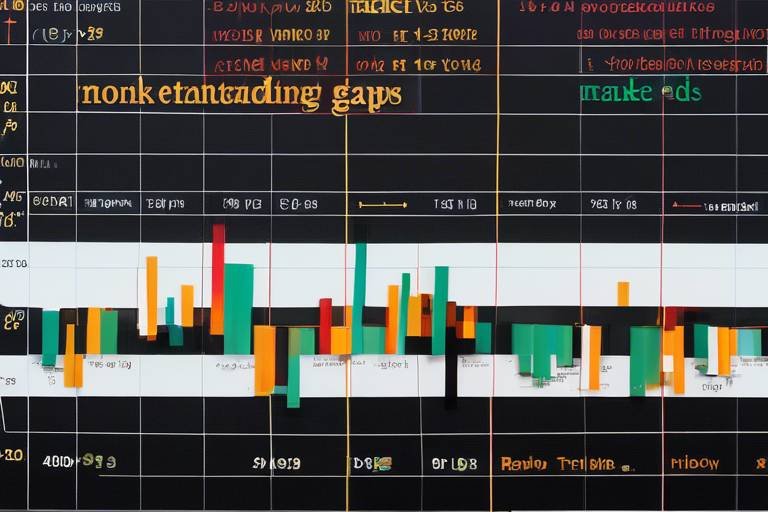How Macroeconomic Trends Affect Cryptocurrency Investments
In today's fast-paced financial landscape, the relationship between macroeconomic trends and cryptocurrency investments has become increasingly intricate and significant. As the world grapples with economic fluctuations, savvy investors are turning their attention to how factors like inflation, interest rates, and government policies can sway the cryptocurrency market. But what does this mean for you as an investor? In this article, we'll dive deep into these connections, exploring how these macroeconomic indicators can shape your investment strategies and influence market behavior.
Macroeconomic indicators are like the pulse of an economy, providing crucial insights into its overall health. Key indicators such as Gross Domestic Product (GDP), unemployment rates, and inflation can significantly impact investor decisions, especially in the volatile world of cryptocurrency. For instance, a rising GDP often signals economic growth, which can boost investor confidence and lead to increased investments in digital assets. Conversely, high unemployment rates may create economic uncertainty, prompting investors to seek refuge in cryptocurrencies as a more stable asset class. Understanding these indicators is essential for any investor looking to navigate the complex interplay between traditional finance and the burgeoning world of digital currencies.
Inflation, the rate at which the general level of prices for goods and services rises, is a critical factor that can drive investors toward cryptocurrencies. When inflation rates soar, the purchasing power of fiat money diminishes, leading individuals to search for alternative stores of value. Cryptocurrencies, particularly Bitcoin, are often touted as a hedge against inflation. As more investors flock to digital assets to preserve their wealth, the demand for cryptocurrencies can skyrocket, subsequently impacting their valuation and market dynamics. This phenomenon creates a fascinating scenario where the very nature of inflation can bolster the appeal of cryptocurrencies as a viable investment option.
Interest rates play a pivotal role in shaping the demand for cryptocurrencies. When central banks adjust interest rates, they directly influence borrowing costs and investment strategies. For example, when interest rates are low, borrowing becomes cheaper, encouraging investors to take on more risk, potentially leading to increased investments in cryptocurrencies. On the other hand, higher interest rates may deter investors from entering the crypto market, as traditional savings accounts and bonds become more attractive. This tug-of-war between interest rates and cryptocurrency demand illustrates the delicate balance that investors must navigate in their decision-making processes.
The cryptocurrency market is not immune to the effects of government policies and regulations. Regulatory frameworks can create uncertainty, impacting investor confidence and market stability. For instance, when a government announces stringent regulations on cryptocurrency trading, it can lead to a swift decline in market prices as investors panic. Conversely, favorable regulations can spur growth and attract new investors. It's essential for investors to stay informed about the regulatory landscape, as changes can have immediate and profound effects on their cryptocurrency investments.
Global economic events, such as financial crises, trade wars, or geopolitical tensions, can lead to increased volatility in cryptocurrency markets. During times of economic uncertainty, investors often seek refuge in alternative assets, including cryptocurrencies. This shift in investment behavior can create significant price fluctuations, presenting both opportunities and risks for investors. Understanding how these global events interact with the cryptocurrency market can help you anticipate potential market movements and adjust your investment strategies accordingly.
The strength of traditional currencies can also impact cryptocurrency investments. A weaker fiat currency may drive investors toward digital assets as an alternative store of value. For example, if the U.S. dollar weakens due to economic instability, investors might turn to Bitcoin or other cryptocurrencies to protect their wealth. This dynamic highlights the interconnectedness of traditional and digital currencies, emphasizing the importance of monitoring currency strength when making investment decisions in the cryptocurrency space.
Investor sentiment is a powerful force in the cryptocurrency market, often swayed by macroeconomic trends. When the economy is thriving, investor confidence typically rises, leading to increased investments in cryptocurrencies. However, during economic downturns, fear and uncertainty can lead to herd behavior, resulting in market bubbles or crashes. Understanding the psychological aspects of investing, alongside macroeconomic indicators, can provide valuable insights into market trends and help you make more informed decisions.
Analyzing current macroeconomic trends can offer a glimpse into future cryptocurrency market movements. By keeping an eye on indicators such as inflation rates, interest rates, and government policies, investors can better position themselves to capitalize on emerging opportunities. It's essential to remain adaptable and informed, as the cryptocurrency landscape continues to evolve in response to broader economic shifts.
- How do macroeconomic trends influence cryptocurrency prices? Macroeconomic trends like inflation and interest rates can affect investor behavior, leading to fluctuations in cryptocurrency prices.
- What role does government regulation play in the crypto market? Government regulations can create uncertainty, impacting investor confidence and market stability.
- Can global economic events affect cryptocurrency investments? Yes, global economic events can lead to increased volatility in cryptocurrency markets, influencing investment strategies.
- How can I use macroeconomic indicators to inform my investments? By analyzing indicators such as GDP, unemployment rates, and inflation, you can gain insights into potential market movements and make informed investment decisions.

Understanding Macroeconomic Indicators
Macroeconomic indicators are like the pulse of an economy, providing essential insights that can guide investors in making informed decisions. These indicators, which include Gross Domestic Product (GDP), unemployment rates, and inflation, serve as crucial benchmarks for evaluating economic health. When we talk about GDP, we’re essentially discussing the total value of all goods and services produced over a specific time period. A growing GDP often signals a thriving economy, which can boost investor confidence, including in the cryptocurrency market.
On the other hand, unemployment rates reveal how many people are out of work and actively seeking employment. High unemployment can lead to decreased consumer spending, which might negatively impact various markets, including cryptocurrencies. Conversely, low unemployment typically means more disposable income, which can lead to increased investment in digital assets.
Inflation, as a key indicator, reflects the rate at which the general level of prices for goods and services rises, eroding purchasing power. When inflation is high, the value of money decreases, prompting investors to seek alternative assets, such as cryptocurrencies, that might offer better protection against inflationary pressures. This relationship between inflation and cryptocurrency is becoming increasingly significant as more investors look for ways to preserve their wealth.
To truly grasp the impact of these macroeconomic indicators on cryptocurrency investments, it’s essential to consider how they interact with each other. For instance, a sudden spike in inflation might lead to changes in monetary policy, such as interest rate hikes, which can further influence investor sentiment. The interconnectedness of these indicators creates a complex web that can lead to significant market fluctuations.
Moreover, understanding these indicators can also help investors identify potential opportunities and risks in the cryptocurrency market. For example, a downturn in the economy may lead to a flight to safety, with investors flocking to cryptocurrencies as a hedge against traditional market volatility. This behavior can create a self-fulfilling prophecy, where increased demand for cryptocurrencies drives their prices higher, regardless of the underlying economic conditions.
In summary, keeping an eye on macroeconomic indicators is vital for anyone looking to navigate the often-turbulent waters of cryptocurrency investments. By understanding how GDP, unemployment rates, and inflation interact, investors can better position themselves to take advantage of market movements and make informed decisions that align with their financial goals.

The Role of Inflation in Cryptocurrency Valuation
Inflation is a term that often sends shivers down the spine of traditional investors. It refers to the rate at which the general level of prices for goods and services rises, eroding purchasing power. Now, you might be wondering, how does this relate to cryptocurrencies? Well, buckle up, because the relationship is both fascinating and crucial for anyone looking to navigate the turbulent waters of digital assets.
When inflation rises, the value of fiat currencies tends to fall. Imagine you have $100 today; in a year with high inflation, that same $100 might only buy you what $90 could today. This decline in purchasing power can lead investors to seek alternative assets that hold value better than traditional money. This is where cryptocurrencies come into play. Many investors view cryptocurrencies, especially Bitcoin, as a hedge against inflation. After all, Bitcoin has a capped supply of 21 million coins, making it a deflationary asset in contrast to fiat currencies that can be printed at will.
Let's break it down a bit more. When inflation is high, consumers and investors often feel the pinch. They may look for assets that are less likely to lose value. This shift in sentiment can drive demand for cryptocurrencies. For instance, during periods of high inflation, you might see a surge in Bitcoin purchases as people rush to safeguard their wealth. The chart below illustrates this phenomenon:
| Year | Inflation Rate (%) | Bitcoin Price (USD) |
|---|---|---|
| 2017 | 2.1 | 1,000 |
| 2020 | 1.2 | 29,000 |
| 2021 | 5.4 | 64,000 |
As you can see from the table, there’s a noticeable correlation between rising inflation rates and the increasing price of Bitcoin. This isn't just coincidence; it underscores a broader trend where inflationary pressures lead investors to flock to cryptocurrencies. But it’s not just Bitcoin that benefits. Other cryptocurrencies, often referred to as altcoins, can also see increased interest as investors diversify their portfolios in response to inflation.
However, it’s essential to approach this with a balanced perspective. While cryptocurrencies can serve as a hedge against inflation, they are not without risks. The market can be incredibly volatile, and prices can swing dramatically in a short time. So, while inflation might drive interest in cryptocurrencies, it can also lead to speculative bubbles where prices soar to unsustainable levels. This is where investor psychology plays a crucial role.
In summary, inflation is more than just an economic term; it’s a powerful force that shapes the cryptocurrency landscape. As inflation rises, so does the allure of digital assets. Investors seek refuge from the eroding value of fiat currencies, leading to increased demand and, often, higher valuations for cryptocurrencies. Staying informed about inflation trends can help investors make smarter decisions in this fast-paced market.
- What is inflation? Inflation is the rate at which the general level of prices for goods and services rises, decreasing purchasing power.
- How does inflation affect cryptocurrency? High inflation can lead investors to seek cryptocurrencies as a hedge against the declining value of fiat currencies.
- Is Bitcoin a good hedge against inflation? Many investors believe Bitcoin serves as a good hedge due to its limited supply, but it is important to consider the volatility of the market.
- What other cryptocurrencies are good during inflation? Various altcoins may also benefit, but it’s crucial to research each asset thoroughly.

Interest Rates and Cryptocurrency Demand
When it comes to the world of investing, interest rates play a pivotal role, and their impact on cryptocurrency demand is no exception. Think of interest rates as the cost of borrowing money; when they are low, borrowing becomes cheaper, and people are more inclined to invest in various assets, including cryptocurrencies. Conversely, when interest rates rise, the cost of borrowing increases, which can dampen investor enthusiasm for riskier assets like Bitcoin or Ethereum.
To put it simply, low interest rates create a favorable environment for cryptocurrency investments. Investors often seek higher returns to offset the low yields from traditional savings accounts or bonds. This search for yield can drive them towards digital currencies, which are perceived as having greater potential for appreciation. As a result, we often see a surge in cryptocurrency demand during periods of low interest rates.
On the flip side, when central banks decide to increase interest rates to combat inflation or stabilize the economy, the impact on cryptocurrencies can be significant. Higher interest rates can lead to a shift in investor behavior. For example, investors might prefer to park their money in interest-bearing assets rather than venture into the volatile world of cryptocurrencies. This shift can result in decreased demand for digital currencies, leading to price corrections and increased market volatility.
Moreover, the relationship between interest rates and cryptocurrency demand isn't just about individual choices; it also affects the broader market sentiment. When interest rates rise, it can signal a tightening of monetary policy, which often leads to uncertainty in financial markets. This uncertainty can cause investors to retreat to safer assets, further decreasing the demand for cryptocurrencies.
It's also essential to consider the global context. Interest rate changes in one country can have ripple effects across the globe. For instance, if the Federal Reserve raises interest rates in the United States, it could lead to capital flight from emerging markets, where investors might feel that cryptocurrencies could provide a hedge against local currency devaluation. As these dynamics play out, the demand for cryptocurrencies can fluctuate based on investor sentiment and perceived risks.
In summary, the interplay between interest rates and cryptocurrency demand is complex and multifaceted. Investors must stay vigilant and consider how changes in interest rates can influence their investment strategies. As we move forward, it will be crucial to monitor these economic indicators to navigate the ever-evolving landscape of cryptocurrency investments effectively.
- How do interest rates affect cryptocurrency prices? Interest rates can influence the cost of borrowing, which in turn affects investor behavior and demand for cryptocurrencies.
- What happens to cryptocurrency demand when interest rates rise? Typically, higher interest rates can lead to reduced demand for cryptocurrencies as investors may prefer safer, interest-bearing assets.
- Are cryptocurrencies a good investment during low interest rates? Yes, low interest rates can create a favorable environment for investing in cryptocurrencies as investors seek higher returns.

Government Policies and Regulations
When it comes to the world of cryptocurrency, can feel like a double-edged sword. On one hand, they can provide a sense of legitimacy and security to the market, while on the other, they can create uncertainty and volatility. Imagine walking a tightrope; one misstep, and you could either find yourself in a safe haven or plummeting into chaos. For investors, understanding this dynamic is crucial.
Regulatory frameworks vary significantly from country to country, and even within regions of the same nation. For instance, in the United States, the SEC (Securities and Exchange Commission) and the CFTC (Commodity Futures Trading Commission) have taken different approaches to cryptocurrency oversight. The SEC has focused on whether certain cryptocurrencies are classified as securities, which can have significant implications for how they are traded and sold. Meanwhile, the CFTC has labeled Bitcoin as a commodity, leading to a different set of regulations. This creates a complex landscape for investors, who must navigate these waters carefully.
Let's not forget about the impact of international regulations. Countries like China have imposed strict bans on cryptocurrency trading and Initial Coin Offerings (ICOs), sending shockwaves through the global market. In contrast, nations like El Salvador have embraced Bitcoin as legal tender, showcasing a stark contrast in approaches. Such differences can lead to market fluctuations as investors react to news from these regions. For example, when China announced its crackdown on cryptocurrencies, many investors rushed to sell, fearing a significant downturn. Conversely, positive regulations in supportive countries can lead to surges in investment and market confidence.
Moreover, taxation policies play a crucial role in shaping investor behavior. In regions where cryptocurrencies are heavily taxed, such as in some parts of Europe, investors may be deterred from entering the market or may engage in tax avoidance strategies. This can lead to a less vibrant market, as potential investors weigh the costs versus the potential gains. Understanding these regulations is akin to reading a map before embarking on a journey; it’s essential for navigating the often unpredictable terrain of cryptocurrency investments.
In addition to these factors, the enforcement of regulations can also vary widely. Some governments may have stringent rules on the books but lack the resources or willingness to enforce them. This can create a gray area where investors may feel emboldened to take risks that they otherwise wouldn’t. However, this could lead to sudden crackdowns, leaving investors scrambling to adjust to new realities. Think of it like a game of Monopoly; you might feel secure in your strategy until someone flips the board over, and suddenly, everything you thought you knew is up in the air.
In conclusion, the influence of government policies and regulations on cryptocurrency investments cannot be overstated. They shape the landscape in which investors operate, impacting everything from market confidence to the very valuation of cryptocurrencies. As the world continues to grapple with the implications of digital currencies, staying informed about regulatory changes is not just advisable; it's essential for anyone looking to navigate this exciting yet unpredictable market.
- What is the role of government regulations in cryptocurrency?
Government regulations can provide legitimacy and security to the cryptocurrency market, but they can also create uncertainty and volatility. - How do international regulations affect cryptocurrency investments?
Different countries have varying regulations, which can lead to market fluctuations as investors react to news from these regions. - What impact do taxation policies have on cryptocurrency?
High taxation can deter investment and lead to less vibrant markets, as potential investors weigh their costs against potential gains.

Global Economic Events and Their Impact
When we talk about the world of cryptocurrencies, it's essential to understand that it's not operating in a vacuum. In fact, the cryptocurrency market is profoundly influenced by global economic events. Think of it like a ripple effect; when something significant happens in the global economy, the ripples can reach even the most decentralized digital assets. For instance, when a country faces a financial crisis, it often leads to increased uncertainty and volatility in the markets. Investors, in their quest for safety, may flock to cryptocurrencies as an alternative, driving prices up and creating a buzz around digital assets.
Consider the 2020 COVID-19 pandemic. This global event sent shockwaves through traditional financial markets, leading to unprecedented government interventions and stimulus packages. As central banks slashed interest rates to stimulate the economy, many investors turned to cryptocurrencies, viewing them as a hedge against the inflation that could arise from such measures. This behavior showcases how economic events can shift investor sentiment dramatically, leading to increased demand for cryptocurrencies.
Another example is the trade wars that have erupted between major economies. When tariffs are imposed, or trade agreements are renegotiated, the uncertainty can lead to fluctuations in currency values. A weaker fiat currency often prompts investors to seek refuge in cryptocurrencies, which are perceived as a more stable store of value. This shift in investment strategy can create sudden spikes in cryptocurrency prices, illustrating the direct correlation between global economic events and market dynamics.
Moreover, geopolitical tensions can also play a significant role. For example, when political instability arises in a country, citizens may lose faith in their local currency, prompting them to invest in cryptocurrencies as a means of preserving their wealth. This behavior not only affects local markets but can also have a cascading effect on the global cryptocurrency landscape. The more people turn to digital assets, the more their value can increase, creating a feedback loop that further entices investors.
To summarize, global economic events can lead to:
- Increased Volatility: Sudden changes in investor sentiment can cause rapid price fluctuations.
- Shifts in Demand: Economic uncertainty often drives investors towards cryptocurrencies.
- Market Bubbles: Herd behavior can lead to inflated prices and subsequent crashes.
Understanding these dynamics is crucial for anyone looking to invest in cryptocurrencies. By keeping an eye on global economic trends, you can better predict potential market movements and make more informed decisions. Remember, in the world of cryptocurrency, knowledge is power, and being aware of how global events can impact your investments can be the difference between profit and loss.
Q: How do global economic events influence cryptocurrency prices?
A: Global economic events create uncertainty and can lead to shifts in investor sentiment, often driving demand for cryptocurrencies as alternative investments.
Q: Can geopolitical tensions affect cryptocurrency investments?
A: Yes, geopolitical tensions can lead to instability in local currencies, prompting investors to seek safety in cryptocurrencies, which can drive their prices up.
Q: What role does inflation play in cryptocurrency investment decisions?
A: Inflation can erode purchasing power, leading investors to consider cryptocurrencies as a hedge against inflation, thereby impacting their demand and valuation.

The Influence of Currency Strength
The strength of traditional currencies plays a pivotal role in shaping the landscape of cryptocurrency investments. When we talk about currency strength, we’re essentially discussing how robust a currency is compared to others. A stronger currency typically means that it has a higher purchasing power, while a weaker currency can lead investors to seek alternatives, like cryptocurrencies. This is akin to a ship navigating through turbulent waters; when the winds are strong (representing a strong currency), the ship sails smoothly. However, when the winds weaken (a weak currency), the ship may be forced to change course, often looking for safer harbors, such as digital assets.
In times of economic uncertainty or when inflation rises, the purchasing power of fiat currencies diminishes. This erosion can lead investors to turn their attention to cryptocurrencies, which are often perceived as a more stable store of value. Imagine holding a dollar that buys less and less each day; it’s no wonder that individuals might look to Bitcoin or Ethereum as a hedge against this devaluation. As a result, the demand for cryptocurrencies can surge, driving up their prices and creating a ripple effect across the market.
Moreover, the relationship between currency strength and cryptocurrency demand can be summarized in a few key points:
- Weak Fiat Currencies: When a country's currency weakens, individuals may invest in cryptocurrencies to preserve their wealth.
- Hedging Against Inflation: Cryptocurrencies are viewed as a hedge against inflation, especially when fiat currencies lose value.
- Global Trade Dynamics: In a globalized economy, fluctuations in currency strength can affect international trade, prompting investors to diversify into cryptocurrencies.
To illustrate this further, let’s take a look at a simple table that showcases how different currencies can impact cryptocurrency investments:
| Currency | Current Strength | Investor Behavior |
|---|---|---|
| US Dollar | Strong | Stable investments; less demand for crypto |
| Euro | Moderate | Mixed; cautious investment in crypto |
| Turkish Lira | Weak | High demand for crypto as a safe haven |
As seen in the table, when the Turkish Lira weakens, there's a notable shift in investor behavior towards cryptocurrencies. This phenomenon isn’t just limited to one country; it resonates globally. Investors are constantly on the lookout for ways to protect their assets, and as currencies fluctuate, so does the appeal of cryptocurrencies. The digital asset market becomes a beacon of hope for those looking to safeguard their investments against the stormy seas of currency devaluation.
In conclusion, the influence of currency strength on cryptocurrency investments cannot be overstated. As traditional currencies ebb and flow, the allure of digital assets continues to grow, reflecting the ever-changing landscape of global finance. Investors must stay vigilant, monitoring not just the performance of cryptocurrencies but also the strength of the currencies they rely on. The interplay between these two elements will undoubtedly shape the future of investment strategies in the cryptocurrency realm.
- How does a weak currency affect cryptocurrency prices? A weak currency often drives investors towards cryptocurrencies as they seek to preserve value, increasing demand and potentially raising prices.
- Can strong currencies lead to decreased interest in cryptocurrencies? Yes, when a currency is strong, investors may feel less need to diversify into cryptocurrencies, leading to lower demand.
- What role does inflation play in currency strength? Inflation erodes purchasing power, often weakening a currency and prompting investors to look for alternatives like cryptocurrencies.

Investor Sentiment and Market Trends
Investor sentiment plays a crucial role in shaping the dynamics of the cryptocurrency market. It's fascinating how emotions can drive decisions that lead to significant price fluctuations. When the market is bullish, optimism reigns, and investors tend to flock towards cryptocurrencies, often disregarding traditional financial principles. This herd mentality can create a bubble, where prices soar to unsustainable levels, only to crash dramatically when reality sets in. Conversely, during bearish phases, fear can grip the market, leading to panic selling and further price declines. Have you ever noticed how news headlines can sway the market in an instant? A single tweet from a high-profile individual or a regulatory announcement can send shockwaves through the crypto community, affecting investor sentiment almost immediately.
To understand this phenomenon better, let's consider a few key factors that influence investor sentiment:
- News and Media Coverage: The way cryptocurrency is portrayed in the news can shape public perception. Positive coverage can attract new investors, while negative reports can deter potential buyers.
- Social Media Influence: Platforms like Twitter and Reddit have become hotbeds for cryptocurrency discussions. The sentiments expressed in these forums can lead to rapid shifts in market trends.
- Market Trends: Historical price movements and patterns can create a psychological impact on investors. For instance, if a cryptocurrency has consistently risen in value, investors may feel more inclined to buy, fearing they might miss out.
Moreover, the relationship between investor sentiment and market trends can often resemble a double-edged sword. For example, when prices are rising, more investors are likely to enter the market, driven by the fear of missing out (FOMO). This influx can push prices even higher, creating a self-fulfilling prophecy. However, when the tide turns and prices start to fall, the same investors may panic, leading to a rapid sell-off that exacerbates the decline. This cyclical behavior highlights the importance of understanding market sentiment as a key component in investment strategies.
Another interesting aspect to consider is the role of sentiment analysis tools. Many investors are now turning to data-driven insights to gauge market sentiment. These tools analyze social media chatter, news articles, and even Google search trends to provide a snapshot of how investors are feeling about a particular cryptocurrency. By leveraging this information, savvy investors can position themselves ahead of the curve, potentially capitalizing on market movements before they happen.
In summary, investor sentiment is a powerful force that can significantly impact market trends in the cryptocurrency space. By staying attuned to the emotional landscape of the market, investors can navigate the often-turbulent waters of cryptocurrency investments with greater confidence. So, the next time you hear about a sudden price surge or drop, remember that behind those numbers are real people driven by emotions, perceptions, and the ever-changing landscape of macroeconomic trends.
- What is investor sentiment? Investor sentiment refers to the overall attitude of investors toward a particular market or asset, influenced by emotions, news, and market trends.
- How does investor sentiment affect cryptocurrency prices? Positive sentiment can lead to increased buying activity, driving prices up, while negative sentiment can result in selling pressure and price declines.
- What tools can help analyze investor sentiment? Tools such as social media sentiment analysis, news aggregation platforms, and market trend analytics can provide insights into how investors feel about cryptocurrencies.

Future Predictions Based on Economic Trends
This article explores the intricate relationship between macroeconomic trends and cryptocurrency investments, examining how factors like inflation, interest rates, and government policies influence market behavior and investor sentiment.
Macroeconomic indicators such as GDP, unemployment rates, and inflation provide valuable insights into the economic environment, impacting investor decisions in the cryptocurrency market.
Inflation affects purchasing power and can drive investors towards cryptocurrencies as a hedge, impacting their valuation and market dynamics.
Changes in interest rates can significantly influence the demand for cryptocurrencies by affecting borrowing costs and investment strategies among investors.
Government regulations and policies can create uncertainty in the cryptocurrency market, impacting investor confidence and market stability.
Global economic events, such as financial crises or trade wars, can lead to increased volatility in cryptocurrency markets, affecting investment strategies.
The strength of traditional currencies can impact cryptocurrency investments, as a weaker fiat currency may drive investors towards digital assets as an alternative store of value.
Investor sentiment is often influenced by macroeconomic trends, which can lead to herd behavior in cryptocurrency investments, creating market bubbles or crashes.
As we look ahead, the interplay between macroeconomic trends and cryptocurrency markets becomes increasingly fascinating. The current economic landscape suggests several potential scenarios that could shape the future of digital currencies. For instance, if inflation continues to rise, we may see a surge in interest towards cryptocurrencies as a hedge against the declining purchasing power of fiat currencies. This trend could lead to a significant increase in demand, pushing prices higher and attracting more institutional investors.
Moreover, the ongoing fluctuations in interest rates will likely play a critical role in determining the appetite for cryptocurrencies. If central banks decide to maintain or lower interest rates to stimulate economic growth, we could witness a capital shift from traditional assets to cryptocurrencies. This scenario might create a more favorable environment for digital currencies, leading to increased market stability and growth.
Another factor to consider is the evolving regulatory landscape. As governments around the world formulate clearer guidelines for cryptocurrency, investor confidence may improve, potentially leading to a more robust market. However, if regulations become overly restrictive, it could stifle innovation and deter investment, resulting in market stagnation.
To visualize these potential impacts, consider the following table that outlines possible future trends based on current economic indicators:
| Economic Indicator | Possible Trend in Cryptocurrency Market | Impact on Investors |
|---|---|---|
| Rising Inflation | Increased interest in cryptocurrencies as a hedge | Potential price surge |
| Lower Interest Rates | Shift of capital towards digital assets | Higher demand and market growth |
| Regulatory Clarity | Improved market stability | Increased investor confidence |
| Geopolitical Tensions | Increased volatility in traditional markets | Greater interest in cryptocurrencies as a safe haven |
In summary, the future of cryptocurrency investments will largely depend on how these macroeconomic trends unfold. Investors who stay informed and adapt their strategies accordingly will be better positioned to navigate this dynamic landscape.
- What are macroeconomic trends? Macroeconomic trends refer to the overall economic factors that influence the economy, such as inflation, interest rates, and government policies.
- How does inflation affect cryptocurrency? Inflation can erode purchasing power, prompting investors to seek alternative assets like cryptocurrencies to preserve value.
- Why are interest rates important for cryptocurrency investments? Interest rates influence borrowing costs and investment strategies, which can directly affect the demand for cryptocurrencies.
- What role do government regulations play in cryptocurrency markets? Regulations can create uncertainty or confidence in the market, impacting investor behavior and market stability.
- How can global economic events impact cryptocurrencies? Events like financial crises can lead to increased volatility in cryptocurrency markets, affecting investment strategies.
Frequently Asked Questions
- How do macroeconomic trends influence cryptocurrency investments?
Macroeconomic trends like inflation, interest rates, and government policies play a significant role in shaping investor behavior in the cryptocurrency market. For instance, when inflation rises, many investors look towards cryptocurrencies as a hedge against declining purchasing power, potentially driving up demand and prices.
- What role does inflation play in cryptocurrency valuation?
Inflation can significantly impact the valuation of cryptocurrencies. As the purchasing power of fiat currencies decreases, cryptocurrencies may be viewed as a more stable store of value. This shift in perception can lead to increased investment in digital assets, thereby affecting their market dynamics and valuation.
- How do interest rates affect the demand for cryptocurrencies?
Interest rates are pivotal in determining the cost of borrowing money. When interest rates are low, borrowing becomes cheaper, which can encourage more investments in cryptocurrencies. Conversely, higher interest rates may deter investors from putting money into digital assets, as they might seek safer, interest-bearing options.
- What impact do government policies have on the cryptocurrency market?
Government regulations and policies can create a sense of uncertainty in the cryptocurrency market. Stricter regulations may lead to decreased investor confidence, while favorable policies can encourage investment. The overall stability of the market can fluctuate based on how governments approach cryptocurrency regulation.
- How do global economic events affect cryptocurrency investments?
Global economic events, such as financial crises or trade wars, can lead to increased volatility in cryptocurrency markets. During times of economic uncertainty, investors may flock to cryptocurrencies as a safer alternative, which can dramatically influence investment strategies and market behavior.
- How does the strength of traditional currencies impact cryptocurrency investments?
The strength of traditional currencies can significantly influence cryptocurrency investments. A weaker fiat currency often prompts investors to seek alternative stores of value, such as cryptocurrencies. This shift in investor behavior can lead to increased demand and higher prices for digital assets.
- What is the relationship between investor sentiment and market trends?
Investor sentiment is closely tied to macroeconomic trends, often resulting in herd behavior in the cryptocurrency market. When investors feel optimistic about economic indicators, they may pour money into cryptocurrencies, leading to market bubbles. Conversely, negative sentiment can trigger sell-offs and market crashes.
- Can analyzing current economic trends help predict future cryptocurrency movements?
Yes, analyzing current macroeconomic trends can provide valuable insights into potential future movements in the cryptocurrency market. By understanding how economic indicators affect investor behavior, investors can make more informed decisions and anticipate market shifts.


















